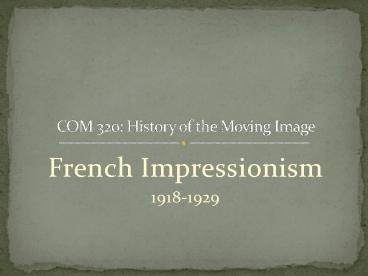French Impressionism - PowerPoint PPT Presentation
1 / 22
Title:
French Impressionism
Description:
... 1912 Photogenie--There are parallels in French Imp painting, e.g.: Mary Cassatt, Lydia Leaning on Her Arms, 1879 Claude Monet, one of his Water Lilies series, ... – PowerPoint PPT presentation
Number of Views:1138
Avg rating:3.0/5.0
Title: French Impressionism
1
COM 320 History of the Moving Image
- French Impressionism
- 1918-1929
2
Defining Characteristics
- Goal is to convey sensations and emotional
impressions . . . conveying the personal vision
of the artist . . . cinema shows us the souls of
people and the essence of objects (photogenie) .
. . Cinema is a synthesis of the other arts
(architecture, painting, sculpture, music,
poetry, dance)
3
Form Style Camera work most important
- Narrative structurepersonal actions and
psychology
Abel Gance, Napoleon, 1927
Jean Epstein, Coeur fidele, 1923
4
Form Style Camera work most important
- Narrative structurepersonal actions and
psychology
Germaine Dulac, The Smiling Madame Beudet, 1922
5
Form Style Camera work most important
- Narrative structurepersonal actions and
psychology - Photogenie that quality which distinguishes a
film shot from the original object photographed
6
- Photogenie--There are parallels in French Imp
painting, e.g.
Frederick Carl Frieseke, Lady in a Garden, 1912
7
- Photogenie--There are parallels in French Imp
painting, e.g.
Mary Cassatt, Lydia Leaning on Her Arms, 1879
Claude Monet, one of his Water Lilies series, c.
1915
8
Form Style Camera work most important
- Narrative structurepersonal actions and
psychology - Photogenie that quality which distinguishes a
film shot from the original object photographed - Optical devices often used to do this
Triptych from Abel Gances Napoleon
9
Form Style Camera work most important
- Narrative structurepersonal actions and
psychology - Photogenie that quality which distinguishes a
film shot from the original object photographed - Optical devices often used to do this
Abel Gance, Napoleon, 1927
Abel Gance, La Roue, 1922
10
Form Style Camera work most important
- Narrative structurepersonal actions and
psychology - Photogenie that quality which distinguishes a
film shot from the original object photographed - Optical devices often used to do this
Jean Epstein, Coeur fidele, 1923
11
Form Style Camera work most important
- Narrative structurepersonal actions and
psychology - Photogenie that quality which distinguishes a
film shot from the original object photographed - Optical devices often used to do this
- Visual rhythm of fast cutting
- Note examples from Abel Gance
- The Charm of Dynamite
12
Form Style Camera work most important
- Narrative structurepersonal actions and
psychology - Photogenie that quality which distinguishes a
film shot from the original object photographed - Optical devices often used to do this
- Visual rhythm of fast cutting
- Location shooting
Abel Gance, JAccuse, 1919
13
Background
- In a commercial film context
- French film in crisis after WWI
- France swamped with German and U.S. films
- Small French companies willing to experiment
14
Other Film Types in that Nation at that Time
- Genre films
- Fantasy (e.g., Rene Clair)
Rene Clair, Le Fantôme du Moulin Rouge, 1924
15
Other Film Types in that Nation at that Time
- Genre films
- Fantasy (e.g., Rene Clair)
- Comedy (e.g., Max Linder)
Max Linder
16
Importance of the Movement
- Influential in style
- Not very important in terms of (box office)
17
Important Practitioners
- Abel Gance (1889-1981)
Abel Gance, Napoleon, 1927
18
Important Practitioners
- Jean Epstein (1897-1953)
Jean Epstein, Coeur fidele, 1923
19
Important Practitioners
- Germaine Dulac (1882-1942)
Germaine Dulac, The Smiling Madame Beudet, 1922
20
The Death of the Movement
- The movements own success led to a diffusion of
its techniques, and a lessening of its impact - French Impressionist filmmakers lost their
independence with the introduction of sound ()
21
Current Influences Applications
- Subjectivity, especially in indie films
- e.g., films of Gus Van Sant
22
- end































